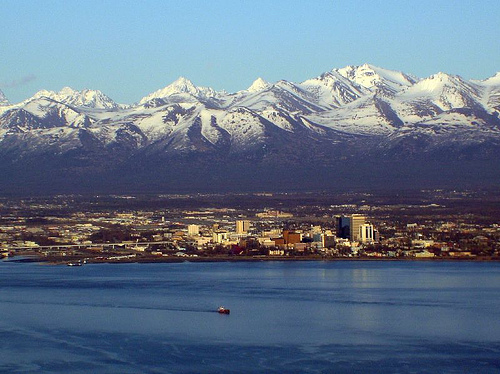If you’ve ever met an Alaskan, you know talking about disappeared sea ice and dead polar bears might get yawns or a semi-concerned shrugs. But try telling her that she’ll need to put wheels on her dog sled, or that her nordic team is now cross-country track, and you’re angling for a punch in the mouth.
Mouthguards, everyone: 2014 was one of the warmest years on record for America’s wintriest state. It was also the warmest for the Bering Sea and Anchorage’s warmest since 1926. In fact, for the first time in recorded history, the temperature never dropped below zero in Anchorage for a whole calendar year.
So with skis stuck in closets and White Christmas dreams dashed (see video above), Alaskans have more reason than ever to pay attention to climate change. From the LA Times:
“To me, the fact that Anchorage won’t dip below zero degrees in calendar year 2014 is just one more signal — as if we needed another one — of a rapidly changing climate,” said Andrew Hartsig, director of the Ocean Conservancy’s Arctic program.
Hartsig said Anchorage’s comparatively balmy weather is consistent with other long-term trends, including diminishing summer sea ice and increasing sea surface temperatures.
“These are definitely red flags that are very consistent with climate change,” said Chris Krenz, senior scientist at Oceana, an international conservation group. “These are anomalies … that show our climate system is off-kilter.”
But Alaska’s hyper-variable weather conditions mean the climate connection isn’t a straight one:
James E. Overland, a research oceanographer with the National Oceanic and Atmospheric Administration, […] argues that Alaska’s very cool heat wave is not evidence of climate change but rather the next stage in a long-term weather pattern that began with six years of warming in the Bering Sea and southern Alaska, followed by six cold years.
“This year, then, was the breakdown of the string of cold years,” Overland said. “What all the scientists are wondering now [is]: Is this just one warm year? Could we flip back to a cold sequence again, or is this the start of a warm sequence? … We don’t know, and it makes a big difference.”
Over at Andy Revkin’s DotEarth, scientist Mike McCracken argues that current weather extremes may offer a preview of new norms under advanced climate change:
Such large variations of the climate likely won’t occur every year over the next few decades given the limited global warming to date, but it would seem likely such conditions will occur more and more frequently as global warming continues, disrupting both social systems and ecosystems.
Of course, concerns about a warmer Alaska extend beyond mushier mushing. Alaska’s valuable pollock (McD’s Filet-o-Fish to you) stocks are threatened by too-warm waters, and even oil companies bemoan their inability to move around Alaska’s vast, roadless interior without reliably packed snow and frozen muskeg. We’d point out the irony in that last one, but we’ve misplaced our Alaska-sized neon irony sign.




